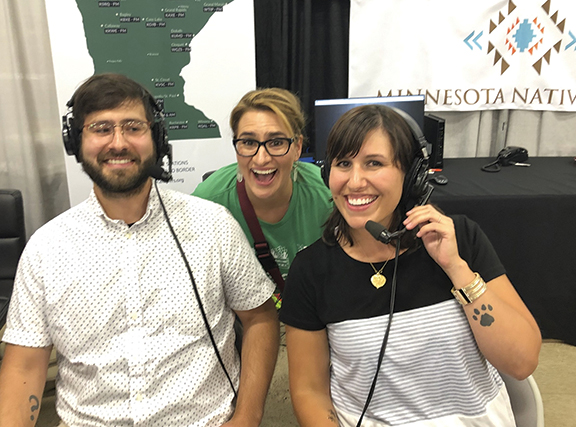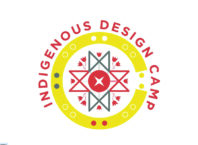
By Lee Egerstrom
An unusual association of independent, community-based radio stations brought forth Native voices and faces for visitors to the Minnesota State Fair this year, and for the stations’ listeners, giving credence to the fair’s nickname as “the Great Minnesota Get-Together.”
Stations that are part of the 18-station Ampers Radio Network broadcasted programs daily at the Aug. 22 to Sept. 2 fair from facilities at the Education Building. New at this year’s fair, however, was a two-hour, live podcast in Aug. 24, “Native Lights: Where Indigenous Voices Shine.”
Native radio broadcasting and now the podcast are keyed to serving Minnesota’s Native communities. They also serve to strengthen ties with “Minnesota neighbors when it is so easy for us to be ignored,” said Leah Lemm, a host and producer of the podcast along with a similar regionally-focused program, called Northern Lights, in tandem with Northern Minnesota radio stations.
Sister and brother Lemm, of Grand Rapids, and Cole Premo, of Minneapolis, host the Native Lights podcast that was started earlier in the year. Members of the Mille Lacs Band of Ojibwe, both are professionals in broadcasting and music.
Podcasts are audio files – or programs – made available for free on the Internet. They can be similar to radio programs broadcast on air but may involve a wide range of creative ways to supply or share anything from news to fun entertainment. This year, the fair podcast was available both on the Internet and broadcast live by Amper stations.
Lemm and Premo, with other Ampers’ personnel, started Native Lights as an outgrowth of Minnesota Native News, a five-minute weekly news show produced for the Ampers stations. Lemm has been a reporter and producer for Native News for the past two years.
Native News and Native Lights try to serve Minnesota’s Native communities that are often ignored, Lemm said in an interview. At the same time, it offers a way for Native people to interact with other Minnesotans at a time when ethnic groups are often demonized.
“We want this to be useful news for Natives and for our non-Native neighbors,” she said. This is important if all Minnesotan seek to understand and respect others.
“Too often, we (Natives) have been demonized. But the eraser treatment is almost worse than demonizing … just making us disappear and go away,” she said.
Accomplished Native guests of the podcast included Lt. Gov. Peggy Flanagan, a citizen of White Earth Nation; Sarah Wheelock, with Twin Cities Native Lacrosse; Hennepin County Library community liaison Allison Waukau, Menominee and Navajo; Rhiana Yazzie, Navajo, founder of the New Native Theatre in the Twin Cities; and James Vukelich Kaagegaabaw, a Minneapolis educator and public speaker who started the “Ojibwe Word of the Day” blog.
How Lemm and Premo humanize their guests was apparent in how they build from their own professional music and personal backgrounds. They got Lieutenant Governor Flanagan to talk about how she evolved from a music background to child psychology to public service.
Following their interviews on the podcasts, the two entertained visitors and listeners with a few or their own composed songs.
When Minnesota Native News announced it would host the live podcast at the fair, reporter and producer Melissa Townsend described the intent this way:
“We’ve built the podcast to feel like you are sitting in a comfy chair shooting the breeze with a couple of food friends. They tell you stories that are hilarious, thoughtful and sometimes devastating. But every one of them offers a gift.”
How this comes about and reaches all corners of the state is a story in itself.
Ampers was started with six community radio stations in 1972 as the Association of Minnesota Public Educational Radio Stations, with a second identity as Ampers, Diverse Radio for Minnesota Communities.
Joel Glaser, chief executive officer since 2009, said the association grew from 12 stations to 18 in the years he’s been CEO. That makes Ampers the largest state community radio network, or association, in the nation.
Among station members joining during Glaser’s tenure were the state’s four tribally-owned community stations. They include KBFT (FM 89.9) for Bois Forte at Nett Lake, KKWE (FM 88.9) for White Earth at Callaway, KOJB (FM 90.1) for Leech Lake at Cass Lake, and WGZS (FM 89.1) for Fond du Lac at Cloquet.
All 18 stations are locally managed and controlled, and all are licensed to a college, school, university, Native tribe or to a community organization.
Erin Warhol, program director for Ampers, said the outreach for Native communities come through by the reception programs receive at colleges and universities. “There is real interest among students and education communities that is real rewarding,” she said.
Ampers stations cover the collegiate and geographical map of Minnesota. In addition to the four tribal stations, the network includes WTIP (serving Grand Marais, Grand Portage and Gunflint Trail), KAXE and KBXE (Grand Rapids, Bemidji, Brainerd), KSRQ (Thief River Falls), KMOJ (Twin Cities), KUOM (Twin Cities), KUMD (Duluth/Superior), KVSC (St. Cloud), KUMM (Morris), KFAI (Twin Cities), KBEM (Twin Cities), KMSU (Mankato/Austin), KQAL (Winona) and KRPR at Rochester.
Looking back, Native Lights host Lemm said the fair podcast was a “first anniversary” celebration because the programming started within the past year. The podcast doesn’t have a set schedule, she said, and future programming “is a work in progress.”
All involved with the news and podcast programs are interacting with listeners and others “to determine what works, what we might do better.” That, she said, includes numbers and sequences for podcasts going forward.
Ampers arts and cultural affairs programming is supported by the Minnesota Arts and Cultural Heritage Fund, authorized by Minnesota voters in 2008, that supports public broadcasters and programming. That include diverse broadcasters such as Minnesota Public Radio, Minnesota Public Television and Ampers.
State Fair and earlier podcasts can be found on the Internet,at: http://ampers.org/
native-lights-podcast. And Ampers programming can be found at: http://ampers.org/
listen-live.






